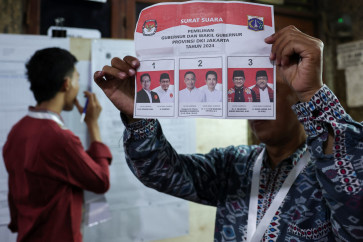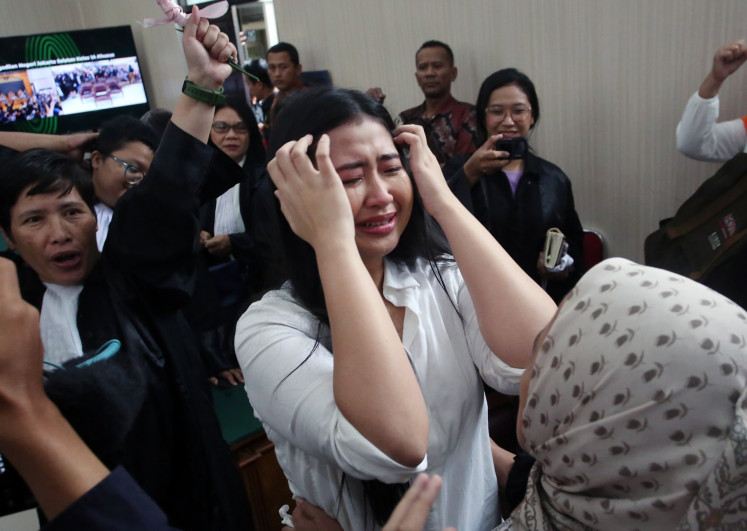Popular Reads
Top Results
Can't find what you're looking for?
View all search resultsPopular Reads
Top Results
Can't find what you're looking for?
View all search resultsWomen’s political representation sadly low
The United States midterm election results are evidence of victory for, among other groups, women
Change text size
Gift Premium Articles
to Anyone
T
he United States midterm election results are evidence of victory for, among other groups, women.
With many male politicians no longer able to stomach US politics under President Donald Trump, many women leaders are passionately stepping in with the desire to shift it in the right direction. Minority women make up the majority of these off-mainstream leaders with strong backgrounds in political activism, civic engagement, community organizing and volunteering for candidates or Congress members.
It must be noted that women’s political involvement in the US has already been very strong. Women have been volunteering and dedicating their lives to local or national political activism and electoral assistance across the country, such as the League of Women Voters, for decades.
Large numbers of women have supported the campaign of other candidates or Congress members, both male and female, of both Republican and Democrat parties. However, women’s representation in the Congress had only shown steady increase up to 14 percent in 2001.
The most important trend to highlight from the midterm elections is the fact that many women who won came from ordinary backgrounds. Many of them had been community organizers or volunteers for their member or candidate representatives for decades.
Numerous racist and hate crime incidents have occurred during the Trump administration, and as a counter, the off-mainstream leaders, especially youths and women, have organized movements such as Black Lives Matter, the Women’s March, The Pink Resistance, the #MeToo Movement, the Parkland Students Movement, and more. They are the seeds and platforms of political activism for many women leaders.
Trump has expedited the representation of women to elected positions. His continued offensive behavior toward women has prompted the rise. Women’s representation in Congress (both the Senate and House of Representatives) rose to 20 percent (107 seats) of 535 seats, of which 78 seats are held by women in the Democratic Party.
Of significance is also the victory of two Muslim American women. Rashida Tlaib, a child of Palestinian immigrants, and Ilhan Omar, a child of Somalian immigrants, will represent the Muslim community in the US Congress.
Another representative with a humble background is the youngest-ever woman elected to Congress, Alexandria Ocasio-Cortez, 29, who is of Puerto Rican descent and won in a landslide with 78 percent of the vote.
Somewhat similar to the US, Indonesia has been battling with the rise of religious extremism, and at the same time there is also a rise in political engagement, more than ever.
In the past five years, the number of people who engage in political discussions in Indonesia has significantly increased, as well as the number of people who engage in political activism.
This is not to compare the two countries, but only to underline the culture of politics and the institutional set-up that allow women’s representation to grow given the identical political episode.
Since the 2009 elections, as a result of the enforcement of Elections Law No. 2/2008 on the 30 percent quota system for women, the percentage of women on the ballots has exceeded the threshold. Even the most conservative Islamic party the Prosperous Justice Party (PKS) had 34 percent women listed on the ballot for the 2014 legislative elections. But only one woman got elected.
Most political parties treated the law as a formality to meet the requirement to contest the elections. It is evident that women’s political representation intrinsically remains a repudiated concept within a party’s culture. The political party is the one who cashes it out to survive or to increase its chance to reach the presidential threshold or simply to survive administrative verification.
Women’s representation in the public sphere is no longer a source of debate in the US. This change is possible because within the American political culture, the political battle centers on legal areas, which has become the foundation of the institutional buildings.
Regrettably, in Indonesian politics, women’s representation continues to be debated, especially in religious and cultural contexts. The legitimate quota system is highly contested and challenged, with debate tending to fluctuate heavily depending on the direction of national politics.
Although the discourse on women’s representation in the country has been improving especially since 2009, parties’ acceptance of the value of women remains low.
Increasing respect for women’s representation requires both political and institutional changes. Therefore, political parties should show explicit efforts to facilitate the process to achieve a substantial change in women’s representation in the legislative councils. However, given the male chauvinist culture within political parties in general, any agenda to change this political environment is most possible through legal pressures, similar to the political history of the birth of the 30 percent quota system for women on the ballot. Shortly after, this article was followed by Article 173 of Elections Law No. 7/2017 that requires 30 percent women representation within the party board of executives.
Unfortunately, at the implementation level, again, this progressive measure was circumvented and swindled by mostly placing women as members rather than leaders of any division within a party.
In order to work, the article needs clear regulations and robust sanctions, such as by provisioning an annex mandating the General Elections Commission (KPU) to require political parties to submit an annual report of their women’s empowerment program and plan for five years ahead, as evidence of their commitment to women’s political representation.
As another critical step to help transform political party culture, lawmakers should consider revising the Elections Law to mandate 50 percent women representation in election administration, starting from the KPU down to poll workers at each polling station.
________________
The writer is the director of the Women and Youth Development Institute (WYDII) and a resident scholar at the Women’s Studies Research Center (WSRC), Brandeis University, the United States.










